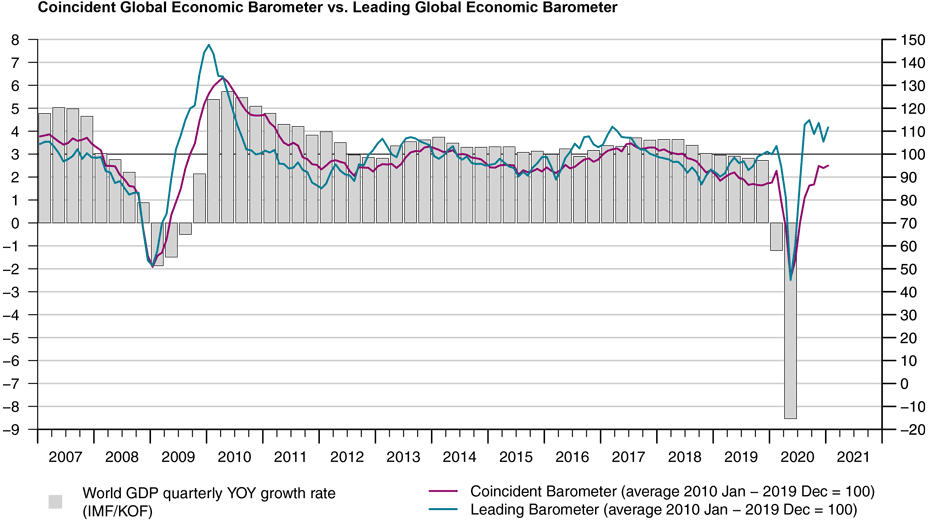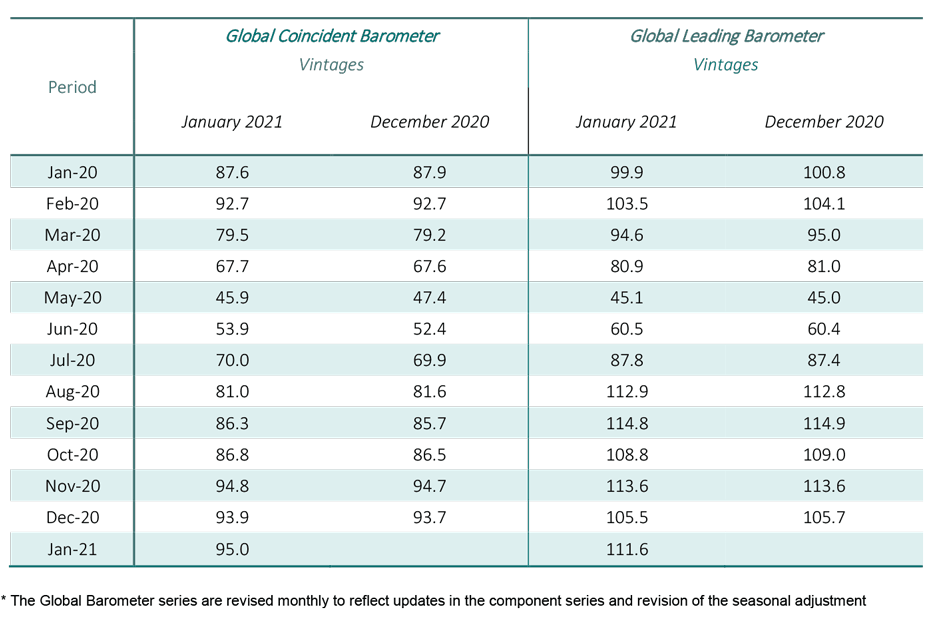Global Economic Barometers reflect cautious optimism despite second wave
The Coincident and Leading Global Economic Barometers rise in January, signaling a continued recovery of global economic activity. The increase in the Coincident Barometer is small and reverses the fall in the previous month. The Leading Barometer increases more noticeably, once again reflecting optimism, which may now be driven by the beginning of vaccination campaigns against COVID-19 in various countries.
The Coincident Global Barometer increases by 1.1 points in January, from 93.9 to 95.0 points, after last month’s temporary interruption of the upward tendency. The Leading Global Barometer rises by 6.1 points to 111.6 points. All the regions contribute positively to the aggregate result of the Coincident Barometer. For the Leading Barometer, the Western Hemisphere moved in the opposite direction to the other regions, contributing negatively to the aggregate result.
“Although the world is in the midst of the second wave of the Covid-19 pandemic, which is stronger than the first, the economy seems to be much less affected this time. The non-pharmaceutical interventions are more fine-tuned, allowing more firms to remain economically active. Perhaps more importantly, the vaccination campaigns that have begun are like shining lights at the end of the tunnel,” concludes Jan-Egbert Sturm, director of KOF Swiss Economic Institute.
Coincident Barometer – regions and sectors
The Coincident Barometers of the three regions increase in January, with Europe contributing 0.7 points (or 64%) to the rise in the aggregate result. The second highest contribution comes from the Asia, Pacific and Africa region, which contributes 0.3 points to the result (26%). The value for Western Hemisphere continues to rise, but at a progressively lower rate. This month, it contributes to the aggregate result with 0.1 points. Immunization campaigns against COVID-19 have been launched in various countries in the region, but the temporarily adverse result in the race between vaccination and the pandemic may have influenced the poor result of the regional indicator. The graph below illustrates the contribution of each region to the deviation of the Coincident Barometer from the historical average of 100 points.
The largest sectorial contribution to the rise of the Coincident Global Barometer in January once again comes from Industry. The other sectors contribute modestly, with Trade positively influencing the aggregate result and the set of variables reflecting the aggregated development of economies (Overall Economic Development) as well as the Services and Construction sectors contributing negatively.
Leading Barometer – regions and sectors
The Leading Global Barometer leads the world economic growth rate cycle by three to six months on average. In January, the Asia, Pacific and Africa region is responsible for more than 90% of the increase in the aggregate indicator, followed by Europe, which contributes 0.7 points, or 11%. Only the Western Hemisphere contributes negatively this month, possibly also reflecting the delay in vaccination plans in some countries and the critical pandemic situation in Brazil and the United States.
In January, all Leading Barometer sectors are facing upswings, with Industry and the set of variables reflecting the aggregated development of economies (Overall Economic Development) being the most optimistic groups (with 120.4 and 115.9 points, respectively). The Trade sector records the highest increase for the month, although it has yet to recover from the losses of the March-May 2020 period, together with Services.
Industry is the sector that contributes the most to the increase in the aggregate indicator for the month, with 4.0 points. Trade contributes with 1.5 points, followed by less noteworthy contributions from the set of variables reflecting the aggregated development of economies (Overall Economic Development), Services and Construction.
The full press release with table and graphs can be found Download here (PDF, 578 KB).
More information on the Global Economic Barometers can be found here.
The Global Economic Barometers
The Global Economic Barometers are a system of indicators enabling timely analysis of global economic development. They represent a collaboration between the KOF Swiss Economic Institute of the ETH Zurich in Switzerland and Fundação Getulio Vargas (FGV), based in Rio de Janeiro, Brazil. The system consists of two composite indicators, the Coincident Barometer and the Leading Barometer. The Coincident Barometer reflects the current state of economic activity, while the Leading Barometer provides a cyclical signal roughly six months ahead of current economic developments.
The two Barometers comprise the results of economic tendency surveys conducted in more than 50 countries with the aim of achieving the broadest possible global coverage. The advantages of economic tendency surveys are that their results are usually readily available and are not substantially revised after first publication.
The Coincident Barometer includes more than 1,000 different time series, while the Leading Barometer consists of over 600 time series. Cross-correlation analysis is used to decide which individual time series are included in the barometers. This involves correlating the individual time series with a reference series. The reference series used is the year-on-year growth rate of global gross domestic product (GDP), where the individual national GDPs are aggregated at purchasing power parity to form global GDP. A time series is only included in a Barometer if it shows a sufficiently high correlation and a suitable synchronization or lead with the reference series. The time period used for this correlation analysis currently runs from January 2010 to December 2019.
The series of the two Barometers are revised each month at publication and are standardized to have a mean of 100 and a standard deviation of 10 for the 10-year period previous to the most recent observations.

